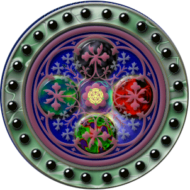A Demonstration of Newton’s Laws of Motion
Introduction
This video segment depicts an idealized instance of Hero’s Engine, the earliest recorded practical steam engine. We know almost nothing about Hero, except that he lived in Alexandria in ancient Egypt. He was a brilliant mathematician, and he wrote about pneumatics. The exact dates of his works are a matter of contention among historians. They place him anywhere between about 100 BCE and 62 AD. Hero’s steam engine is often used as a simple demonstration of Newton’s three laws of motion.
Newton’s First Law – First Part
Newton’s first law has two parts. The first part, “Unless acted upon by some external force, an object at rest tends to remain at rest.” The sphere, initially at rest, does not immediately begin to rotate. As the steam jets build in force, the sphere begins to turn slowly at first, then picks up speed. This illustrates the first part of Newton’s first law. An object at rest, in this case, the hero engine sphere, has a tendency to remain at rest. Typically, we call this characteristic inertia.
Newton’s First Law – Second Part
The second part of Newton’s first law, “Unless acted upon by some external force, an object in motion continues in a straight line.” This video clip follows the tracks of individual steam particles as they leave the jet nozzles. Even though the engine is spinning rapidly about a central axis, the steam, when free of the apparatus, continues along the path or vector it had when ejected from the nozzle.
Newton’s Second Law
Newton’s second law. “Force is equal to mass times acceleration.” It’s somewhat more difficult to relate Hero’s engine to Newton’s second law, because the rotary motion of the engine requires a slightly different formula. The rotational analog to force equals mass times acceleration is expressed as torque equals moment of inertia times angular acceleration, or T equals IA. Torque is defined as a force that produces motion around a rotational axis. In the case of Hero’s engine, each jet nozzle exerts a force opposite the other. In a perfectly balanced system, these opposing forces will cause the engine to rotate about a point exactly midway between them.
Newton’s Third Law
Newton’s third law. “For every action, there is an equal and opposite reaction.” As depicted in this video segment, Newton’s third law states that the force of the steam pushing rearward against the jet nozzle is matched by an equal opposite force of the nozzle pushing back, propelling the sphere forward. Again, our illustration is greatly simplified. We have magically eliminated effects due to gravity and friction, and our engine spins perfectly balanced. When researchers or hobbyists attempt to build a hero’s engine out of real-world materials, they find that it very quickly becomes unstable, begins to wobble about several axes at once, and eventually spins out of control. If the heat is not removed quickly enough, the engine will be destroyed.
Source: The Mathematical Principles of Natural Philosophy (1729) Newton’s Principles of Natural Philosophy, Dawsons of Pall Mall, 1968;
